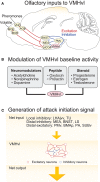Ventromedial Hypothalamus and the Generation of Aggression
- PMID: 29375329
- PMCID: PMC5770748
- DOI: 10.3389/fnsys.2017.00094
Ventromedial Hypothalamus and the Generation of Aggression
Abstract
Aggression is a costly behavior, sometimes with severe consequences including death. Yet aggression is prevalent across animal species ranging from insects to humans, demonstrating its essential role in the survival of individuals and groups. The question of how the brain decides when to generate this costly behavior has intrigued neuroscientists for over a century and has led to the identification of relevant neural substrates. Various lesion and electric stimulation experiments have revealed that the hypothalamus, an ancient structure situated deep in the brain, is essential for expressing aggressive behaviors. More recently, studies using precise circuit manipulation tools have identified a small subnucleus in the medial hypothalamus, the ventrolateral part of the ventromedial hypothalamus (VMHvl), as a key structure for driving both aggression and aggression-seeking behaviors. Here, we provide an updated summary of the evidence that supports a role of the VMHvl in aggressive behaviors. We will consider our recent findings detailing the physiological response properties of populations of VMHvl cells during aggressive behaviors and provide new understanding regarding the role of the VMHvl embedded within the larger whole-brain circuit for social sensation and action.
Keywords: VMHvl; aggression; mouse; neural activity; neuromodulation.
Figures




Similar articles
-
Decoding ventromedial hypothalamic neural activity during male mouse aggression.J Neurosci. 2014 Apr 23;34(17):5971-84. doi: 10.1523/JNEUROSCI.5109-13.2014. J Neurosci. 2014. PMID: 24760856 Free PMC article.
-
Hypothalamic Control of Conspecific Self-Defense.Cell Rep. 2019 Feb 12;26(7):1747-1758.e5. doi: 10.1016/j.celrep.2019.01.078. Cell Rep. 2019. PMID: 30759387 Free PMC article.
-
Hypothalamic control of male aggression-seeking behavior.Nat Neurosci. 2016 Apr;19(4):596-604. doi: 10.1038/nn.4264. Epub 2016 Mar 7. Nat Neurosci. 2016. PMID: 26950005 Free PMC article.
-
Recent advances in understanding the role of the hypothalamic circuit during aggression.Front Syst Neurosci. 2014 Sep 25;8:168. doi: 10.3389/fnsys.2014.00168. eCollection 2014. Front Syst Neurosci. 2014. PMID: 25309351 Free PMC article. Review.
-
Hypothalamic control of innate social behaviors.Science. 2023 Oct 27;382(6669):399-404. doi: 10.1126/science.adh8489. Epub 2023 Oct 26. Science. 2023. PMID: 37883550 Free PMC article. Review.
Cited by
-
Estimation of Current and Future Physiological States in Insular Cortex.Neuron. 2020 Mar 18;105(6):1094-1111.e10. doi: 10.1016/j.neuron.2019.12.027. Epub 2020 Jan 16. Neuron. 2020. PMID: 31955944 Free PMC article.
-
Functions of medial hypothalamic and mesolimbic dopamine circuitries in aggression.Curr Opin Behav Sci. 2018 Dec;24:104-112. doi: 10.1016/j.cobeha.2018.06.011. Epub 2018 Jul 3. Curr Opin Behav Sci. 2018. PMID: 30746430 Free PMC article.
-
A line attractor encoding a persistent internal state requires neuropeptide signaling.Cell. 2024 Oct 17;187(21):5998-6015.e18. doi: 10.1016/j.cell.2024.08.015. Epub 2024 Aug 26. Cell. 2024. PMID: 39191257
-
Sugar Beverage Habitation Relieves Chronic Stress-Induced Anxiety-like Behavior but Elicits Compulsive Eating Phenotype via vLSGAD2 Neurons.Int J Mol Sci. 2022 Dec 30;24(1):661. doi: 10.3390/ijms24010661. Int J Mol Sci. 2022. PMID: 36614104 Free PMC article.
-
Changes in neuronal activity across the mouse ventromedial nucleus of the hypothalamus in response to low glucose: Evaluation using an extracellular multi-electrode array approach.J Neuroendocrinol. 2020 Mar;32(3):e12824. doi: 10.1111/jne.12824. Epub 2020 Feb 23. J Neuroendocrinol. 2020. PMID: 31880369 Free PMC article.
References
Publication types
Grants and funding
LinkOut - more resources
Full Text Sources
Other Literature Sources

